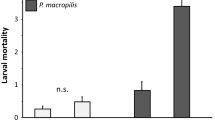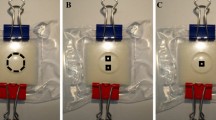Abstract
Numerous studies have been devoted to estimating the intrinsic rates of increase, rm, of phytoseiid and tetranychid mites. Intrinsic rates of increase may be helpful for biological control purposes, but how exactly is still unclear. In this paper, we show how rms can be used to this end, by using a simple model for the local dynamics of predator and prey populations. The application of this model critically depends on what is meant by the term local. Here, we define it as a spatial scale at which predator and prey dynamics are strongly coupled.
Furthermore, it is shown that the rm of phytoseiid and tetranychid mites are correlated with mean and peak oviposition rates. Since peak oviposition rates are easy to determine, the regression equation provides a quick and simple way toestimate rm. Subsequently, it is possible to calculate appropriate predator/prey ratios for biological control by using the model and the estimated rm.
Similar content being viewed by others
References
Ashihara, W., Hamamura, T. and Shinkaji, N., 1978. Feeding, reproduction, and development ofPhytoseiulus persimilis Athias-Henriot (Acarina: Phytoseiidae) on various food substances. Bull. Fruit Tree Res. Stn., Jpn. Ser. E, 2: 91–98.
Badii, M.H., McMurtry, J.A. and Johnson, H.G., 1990. Comparative life-history studies on the predaceous mitesTyphlodromus annectens andTyphlodromus porresi (Acari: Mesostigmatidae: Phytoseiidae). Exp. Appl. Acarol., 10: 129–136.
Blommers, L., 1976. Capacities for increase and predation inAmblyseius bibens (Acarina: Phytoseiidae). Z. Angew. Entomol., 81: 225–244.
Bruce-Oliver, S.J. and Hoy, M.A. 1990. Effect of prey stage on life-table attributes of a genetically manipulated strain ofMetaseiulus occidentalis (Acari: Phytoseiidae). Exp. Appl. Acarol., 9: 201–207.
Carey, J.R. and Krainacker, D.A., 1988. Demographic analysis of mite populations: extensions of stable theory. Exp. Appl. Acarol., 4: 191–210.
Charlet, L.D. and McMurtry, J.A. 1977. Systematics and bionomics of predaceous and phytophagous mites associated with pine foliage in California. Hilgardia, 45: 173–236.
Diekmann, O., Metz, J.A.J. and Sabelis, M.W., 1988. Mathematical models of predator-preyplant interactions in a patchy environment. Exp. Appl. Acarol., 5: 319–342.
Edelstein-Keshet, L., 1988. Mathematical Models in Biology. Random House, New York, NY, 586 pp.
Friese, D.D. and Gilstrap, F.E., 1982. Influence of prey availability on reproduction and prey consumption ofPhytoseiulus persimilis, Amblyseius californicus andMetaseiulus occidentalis (Acarina: Phytoseiidae). Int. J. Acarol., 8: 85–89.
Helle, W. and Sabelis, M.W. (Editors), 1985a. Spider Mites, Their Biology, Natural Enemies and Control, Vol. 1A. Elsevier, Amsterdam, 403 pp.
Helle, W. and Sabelis, M.W. (Editors), 1985b. Spider Mites, Their Biology, Natural Enemies and Control, Vol. 1B. Elsevier, Amsterdam, 458 pp.
Janssen, A., Hofker, C.D., Braun, A.R., Mesa, N., Sabelis, M.W. and Bellotti, A.C., 1990. Preselecting predatory mites for biological control: the use of an olfactometer. Bull. Entomol. Res., 80: 177–181.
Lababidi, M.S., 1988. Biologische Bekämpfungsmöglichkeiten der BaumwollspinnmilbeTetranychus cinnabarinus (Boisduval) (Acari: Tetranychidae). PhD. Thesis, Institut für Pflanzenkrankheiten der Rheinischen Friedrich-Wilhelms-Universität Bonn, 158 pp.
Laing, J.E., 1968. Life history and life table ofPhytoseiulus persimilis Athias-Henriot. Acarologia, 10: 578–588.
Lewontin, R.C., 1965. Selection for colonizing ability. In: H.G. Baker and G. Ledyard Stebbins (Editors), The Genetics of Colonizing Species. Academic Press, New York, NY, pp. 77–91.
Ma, W. and Laing, J.E., 1973. Biology, potential for increase and prey consumption ofAmblyseius chilenensis (Dosse) (Acarina: Phytoseiidae). Entomophaga, 18: 47–60.
McMurtry, J.A., 1982. The use of phytoseiids for biological control; progress and future prospects. In: M.A. Hoy (Editor), Recent Advances in Knowledge of the Phytoseiidae. University of California Publication 3284, pp. 23–48.
McMurtry, J.A., 1992. Dynamics and potential impact of ‘generalist’ phytoseiids in agroecosystems and possibilities for establishment of exotic species. Exp. Appl. Acarol., 14: 371–382.
Murdoch, W.W., Chesson, J. and Chesson, P.L., 1985. Biological control in theory and practice. Am. Nat., 125: 344–366.
Nachman, G., 1981. Temporal and spatial dynamics of an acarine predator-prey system. J. Anim. Ecol., 50: 435–451.
Nachman, G., 1987a. System analysis of acarine predator-prey interactions. I. A stochastic simulation model of spatial processes. J. Anim. Ecol., 56: 247–256.
Nachman, G., 1987b. System analysis of acarine predator-prey interactions. II. The role of spatial processes in system stability. J. Anim. Ecol., 56: 267–281.
Prasad, V., 1967. Biology of the predatory mitePhytoseiulus macropilis in Hawaii (Acarina: Phytoseiidae). Ann. Entomol. Soc. Am., 60: 905–908.
Sabelis, M.W., 1981. Biological control of two-spotted spider mites using phytoseiid predators. Agric. Research reports 910. Pudoc, Wageningen, 242 pp.
Sabelis, M.W., 1985. Capacity for population increase. In: W. Helle and M.W. Sabelis (Editors), Spider Mites, Their Biology, Natural Enemies and Control, Vol. 1B. Elsevier, Amsterdam, pp. 35–41.
Sabelis, M.W., 1990. How to analyse prey preference when prey density varies? A new method to discriminate between effects of gut fullness and prey type composition. Oecologia, 82: 289–298.
Sabelis, M.W., 1991. Life-history evolution of spider mites. In: R. Schuster and P.W. Murphy (Editors), The Acari. Reproduction, Development and Life-history Strategies. Chapman and Hall, London, pp. 23–29.
Sabelis, M.W., 1992. Predatory arthropods. In: M.J. Crawley (Editor), Natural Enemies: The Population Biology of Predators, Parasites and Diseases. Blackwell, Oxford (in press).
Sabelis, M.W. and Dicke, M., 1985. Long range dispersal and searching behaviour. In: W. Helle and M.W. Sabelis (Editors), Spider Mites, Their Biology, Natural Enemies and Control, Vol. 1B. Elsevier, Amsterdam, pp. 141–160.
Sabelis, M.W. and Janssen, A., 1992. Evolution of life history patterns in the Phytoseiidae. In: M.A. Houck (Editor), Life History and Reproductive Patterns of Mites. Chapman and Hall, New York (in press).
Sabelis, M.W. and Laane, W.E.M., 1986. Regional dynamics of spider-mite populations that become extinct locally because of food source depletion and predation by phytoseiid mites. In: J.A.J. Metz and O. Diekmann (Editors), Dynamics of Physiologically Structured Populations. Lecture Notes in Biomathematics, 68. Springer, Berlin, pp. 345–375.
Sabelis, M.W. and Van der Meer, J. 1986. Local dynamics of the interaction between predatory mites and two-spotted spider mites. In: J.A.J. Metz and O. Diekmann (Editors), Dynamics of Physiological Structured Populations. Lecture Notes in Biomathematics, 68. Springer, pp. 322–344.
Sabelis, M.W., Vermaat, J.E. and Groeneveld, A., 1984. Arrestment responses of the predatory mitePhytoseiulus persimilis to steep odour gradients of a kairomone. Physiol. Entomol., 9: 437–446.
Sabelis, M.W., Diekmann, O. and Jansen, V.A.A., 1991. Metapopulation persistence despite local extinction: predator-prey patch models of the Lotka-Volterra type. Biol. J. Linn. Soc., 42: 267–283.
Saito, Y., 1990. Life-history and feeding habit ofTyphlodromus bambusae, a specific predator ofSchizotetranychus celarius (Acari: Phytoseiidae, Tetranychidae). Exp. Appl. Acarol., 10: 45–51.
Sanderson, J.P. and McMurtry, J.A., 1984. Life history studies of the predaceous mitePhytoseius haweiiensis. Entomol. Exp. Appl., 35: 227–234.
Shih, C.I.T. and Shieh, J.N., 1979. Biology, life table, predation potential and intrinsic rate of increase ofAmblyseius longispinosus (Evans). Plant Prot. Bull. Taiwan, 21: 175–183.
Shih, C.I., Poe, S.L. and Cromroy, H.L., 1979. Biology and predation ofPhytoseiulus macropilis onTetranychus urticae. Fla. Entomol., 62: 48–53.
Smith, J.C. and Newsom, L.D., 1970a. The biology ofAmblyseius fallacis (Acarina: Phytoseiidae) at various temperature and photoperiod regimes. Ann. Entomol. Soc. Am., 63: 460–462.
Smith, J.C. and Newsom, L.D., 1970b. Laboratory evaluation ofA. fallacis as a predator of tetranychid mites. J. Econ. Entomol., 63: 1876–1878.
Takafuji, A., Tsuda, Y. and Miki, T., 1983. System behaviour in predator-prey interaction with special reference to acarine predator prey system. Res. Pop. Ecol., Suppl. 3: 75–92.
Tanigoshi, L.K., 1982. Advances in knowledge of the biology of the Phytoseiidae. In: M.A. Hoy (Editor), Recent Advances in Knowledge of the Phytoseiidae. University of California Publication 3284, pp. 1–22.
Tanigoshi, L.K. and McMurtry, J.A., 1977. The dynamics of predation ofStethorus picipes (Coleoptera: Coccinellidae) andTyphlodromus floridanus on the preyOligonychus punicae (Acarina: Phytoseiidae, Tetranychidae). Hilgardia, 45: 237–288.
Van Dinh, N., Janssen, A. and Sabelis, M.W., 1988. Reproductive success ofAmblyseius idaeus andA. anonymus on a diet of two-spotted spider mites. Exp. Appl. Acarol., 4: 41–51.
Van Rijn, P.C.J. and Sabelis, M.W., 1990. Pollen availability and its effect on the maintenance of populations ofAmblyseius cucumeris, a predator of thrips. Med. Fac. Landbouww. Rijksuniv. Gent, 55: 335–341.
Van Rijn, P.C.J. and Van Houten, Y.M., (1991). Life history ofAmblyseius cucumeris andA. barkeri on a diet of pollen. In: F. Dusbábek and V. Bukva (Editors), Modern Acarology, Vol. 2. Academia, Prague, pp. 647–654.
Author information
Authors and Affiliations
Rights and permissions
About this article
Cite this article
Janssen, A., Sabelis, M.W. Phytoseiid life-histories, local predator-prey dynamics, and strategies for control of tetranychid mites. Exp Appl Acarol 14, 233–250 (1992). https://doi.org/10.1007/BF01200566
Issue Date:
DOI: https://doi.org/10.1007/BF01200566




